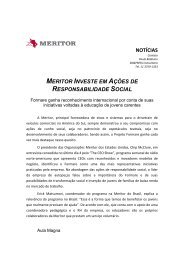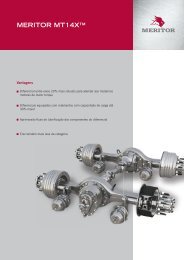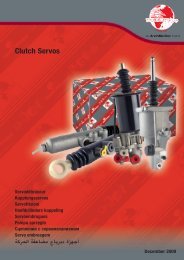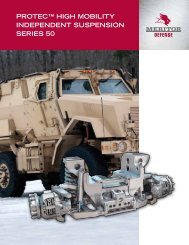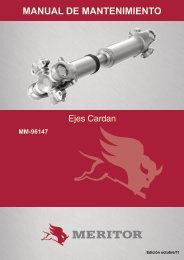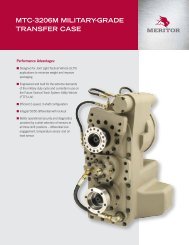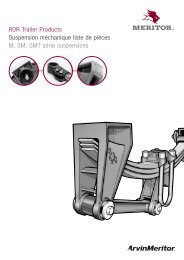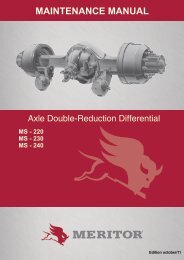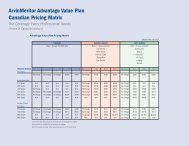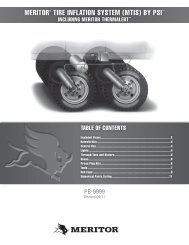MAINTENANCE MANUAL - Meritor
MAINTENANCE MANUAL - Meritor
MAINTENANCE MANUAL - Meritor
You also want an ePaper? Increase the reach of your titles
YUMPU automatically turns print PDFs into web optimized ePapers that Google loves.
7. Release conical washers, if used, of the<br />
flange of the axle shaf. Figure. FIGURE 11.1.<br />
STUD NUT<br />
PARAFUSO<br />
NON CONICAL<br />
WASHER<br />
RETENTION<br />
CONICAL WASHER<br />
RETENTION<br />
WASHER<br />
WASHER<br />
8. Identify each axle shaft to be removed from<br />
the axle assembly so they can be installed<br />
in the same location after transporting or repair<br />
is completed.<br />
9. Remove the conical washers, the axle shafts<br />
and gaskets, if used. Figure 11.1.<br />
10. Desconecte a mangueira de ar do cilindro<br />
de acionamento do mecanismo de bloqueio.<br />
FIGURE 11.2<br />
HOLE IN BED<br />
CILYNDER<br />
AIR HOSE<br />
<strong>MAINTENANCE</strong> <strong>MANUAL</strong><br />
CONICAL<br />
WASHER<br />
GASKET<br />
AXLE<br />
SHAFT OR<br />
FLANGE<br />
STUD<br />
SHAFT<br />
HUB AXLE<br />
Figure 11.1<br />
THREADED DCDL<br />
CAPSCREW<br />
<strong>MANUAL</strong> ENGAG-<br />
ING<br />
Figure 11.2<br />
Vehicle Towing Instructions<br />
11. Remove the manual engaging capscrew<br />
from the storage hole. The storage hole of<br />
threaded shift assemblies is located in the<br />
shift tower of the differential, next to the cylinder.<br />
FIgure 11.2.<br />
12. Lock or gear the main differential using the<br />
manual engaging capscrew. See the Section<br />
6.<br />
13. Remove the remaining axle shaft(s) as necessary<br />
from the axle(s) that will remain on<br />
the road when the vehicle is transported<br />
14. Install a cover over the open end of each<br />
hub where an axle shaft was removed. This<br />
will prevent dirt from entering the bearing<br />
cavity and minimize loss of lubricant<br />
NOTE:<br />
If an air supply will be used for the brake system<br />
of the transported vehicle, continue with<br />
Steps 15 and 16, otherwise continue with<br />
Step 17.<br />
15. Connect an auxiliary air supply to the brake<br />
system of the vehicle that is being transported.<br />
Before moving the vehicle, charge<br />
the brake system with the correct amount of<br />
air pressure to operate the brakes. Refer to<br />
the instructions supplied by the manufacturer<br />
of the vehicle for procedures and specifications.<br />
If an auxiliary air supply is not used,<br />
continue with Step 17.<br />
16. When the correct amount of air pressure<br />
is in the brake system, release the parking<br />
brakes of the vehicle that is being transported.<br />
Step 17 is not required.<br />
17. If there are spring or parking brakes on the<br />
axle(s) that will remain on the road when<br />
the vehicle is transported, and they cannot<br />
be released by air pressure, manually<br />
compress and lock each spring so that the<br />
brakes are released. See the manufacturer’s<br />
instructions.<br />
Towing or Drive-Away<br />
1. If an auxiliary air supply was used, apply the<br />
vehicle parking brakes using the switch inside<br />
the cab of the vehicle. If an auxiliary air supply<br />
was not used, begin with Step 2.<br />
111



